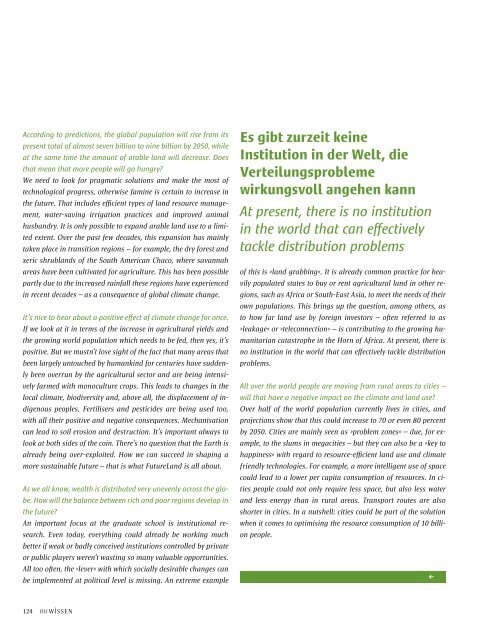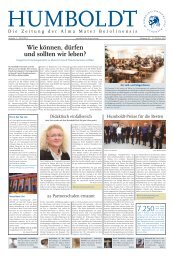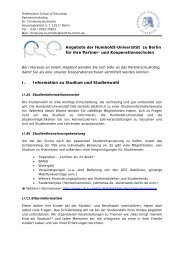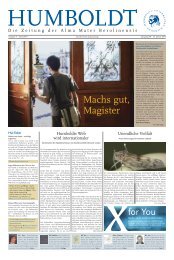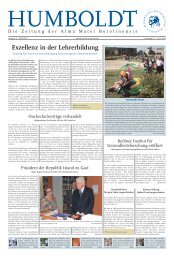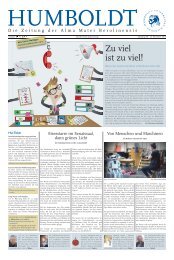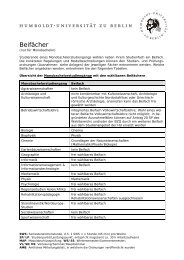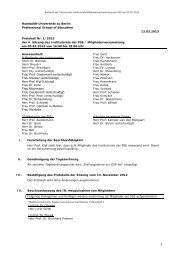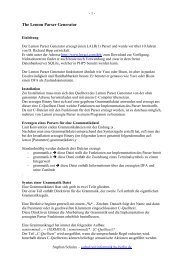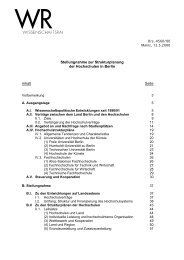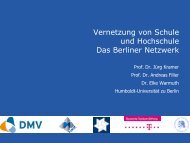hu wissen 3 (pdf) - Humboldt-Universität zu Berlin
hu wissen 3 (pdf) - Humboldt-Universität zu Berlin
hu wissen 3 (pdf) - Humboldt-Universität zu Berlin
Sie wollen auch ein ePaper? Erhöhen Sie die Reichweite Ihrer Titel.
YUMPU macht aus Druck-PDFs automatisch weboptimierte ePaper, die Google liebt.
According to predictions, the global population will rise from its<br />
present total of almost seven billion to nine billion by 2050, while<br />
at the same time the amount of arable land will decrease. Does<br />
that mean that more people will go <strong>hu</strong>ngry?<br />
We need to look for pragmatic solutions and make the most of<br />
technological progress, otherwise famine is certain to increase in<br />
the future. That includes efficient types of land resource management,<br />
water-saving irrigation practices and improved animal<br />
<strong>hu</strong>sbandry. It is only possible to expand arable land use to a limited<br />
extent. Over the past few decades, this expansion has mainly<br />
taken place in transition regions − for example, the dry forest and<br />
xeric shrublands of the South American Chaco, where savannah<br />
areas have been cultivated for agriculture. This has been possible<br />
partly due to the increased rainfall these regions have experienced<br />
in recent decades – as a consequence of global climate change.<br />
It’s nice to hear about a positive effect of climate change for once.<br />
If we look at it in terms of the increase in agricultural yields and<br />
the growing world population which needs to be fed, then yes, it’s<br />
positive. But we mustn’t lose sight of the fact that many areas that<br />
been largely untouched by <strong>hu</strong>mankind for centuries have suddenly<br />
been overrun by the agricultural sector and are being intensively<br />
farmed with monoculture crops. This leads to changes in the<br />
local climate, biodiversity and, above all, the displacement of indigenous<br />
peoples. Fertilisers and pesticides are being used too,<br />
with all their positive and negative consequences. Mechanisation<br />
can lead to soil erosion and destruction. It’s important always to<br />
look at both sides of the coin. There’s no question that the Earth is<br />
already being over-exploited. How we can succeed in shaping a<br />
more sustainable future – that is what FutureLand is all about.<br />
As we all know, wealth is distributed very unevenly across the globe.<br />
How will the balance between rich and poor regions develop in<br />
the future?<br />
An important focus at the graduate school is institutional research.<br />
Even today, everything could already be working much<br />
better if weak or badly conceived institutions controlled by private<br />
or public players weren’t wasting so many valuable opportunities.<br />
All too oen, the »lever« with which socially desirable changes can<br />
be implemented at political level is missing. An extreme example<br />
Es gibt <strong>zu</strong>rzeit keine<br />
Institution in der Welt, die<br />
Verteilungsprobleme<br />
wirkungsvoll angehen kann<br />
At present, there is no institution<br />
in the world that can effectively<br />
tackle distribution problems<br />
of this is »land grabbing«. It is already common practice for heavily<br />
populated states to buy or rent agricultural land in other regions,<br />
such as Africa or South-East Asia, to meet the needs of their<br />
own populations. This brings up the question, among others, as<br />
to how far land use by foreign investors – oen referred to as<br />
»leakage« or »teleconnection« − is contributing to the growing <strong>hu</strong>manitarian<br />
catastrophe in the Horn of Africa. At present, there is<br />
no institution in the world that can effectively tackle distribution<br />
problems.<br />
All over the world people are moving from rural areas to cities –<br />
will that have a negative impact on the climate and land use?<br />
Over half of the world population currently lives in cities, and<br />
projections show that this could increase to 70 or even 80 percent<br />
by 2050. Cities are mainly seen as »problem zones« – due, for example,<br />
to the slums in megacities – but they can also be a »key to<br />
happiness« with regard to resource-efficient land use and climate<br />
friendly technologies. For example, a more intelligent use of space<br />
could lead to a lower per capita consumption of resources. In cities<br />
people could not only require less space, but also less water<br />
and less energy than in rural areas. Transport routes are also<br />
shorter in cities. In a nutshell: cities could be part of the solution<br />
when it comes to optimising the resource consumption of 10 billion<br />
people.<br />
v<br />
124


